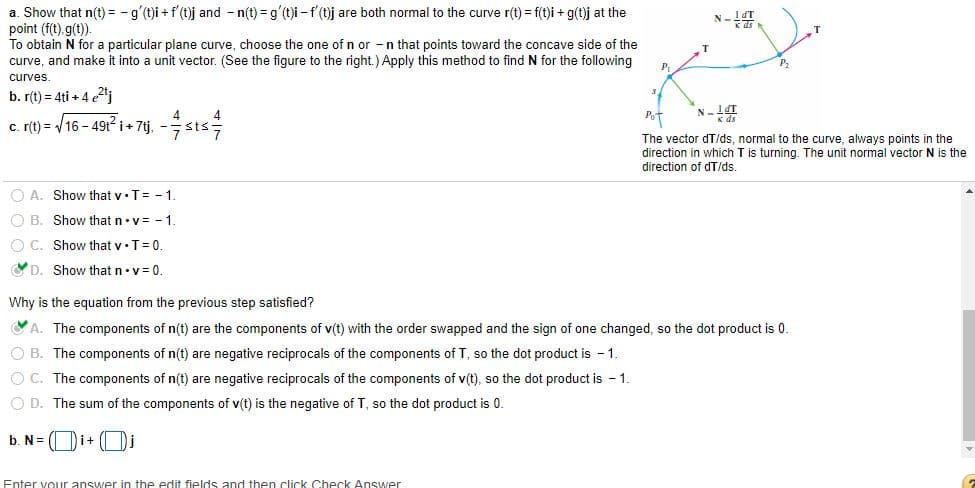solve part B
Algebra & Trigonometry with Analytic Geometry
13th Edition
ISBN:9781133382119
Author:Swokowski
Publisher:Swokowski
Chapter11: Topics From Analytic Geometry
Section: Chapter Questions
Problem 18T
Related questions
Concept explainers
Equations and Inequations
Equations and inequalities describe the relationship between two mathematical expressions.
Linear Functions
A linear function can just be a constant, or it can be the constant multiplied with the variable like x or y. If the variables are of the form, x2, x1/2 or y2 it is not linear. The exponent over the variables should always be 1.
Question
solve part B

Transcribed Image Text:a. Show that n(t) = -g'(t)i + f'(t)j and - n(t) = g'(t)i - f (t)j are both normal to the curve r(t) = f(t)i + g(t)j at the
point (f(t).g(t)).
To obtain N for a particular plane curve, choose the one of n or -n that points toward the concave side of the
curve, and make it into a unit vector. (See the figure to the right.) Apply this method to find N for the following
N-4.
P.
curves.
b. r(t) = 4ti + 4 j
Pot
c. (t) = /16 - 49t i+ 7tj, - sts
The vector dT/ds, normal to the curve, always points in the
direction in which T is turning. The unit normal vector
is the
direction of dT/ds
O A. Show that v•T= - 1.
O B. Show that n•v= - 1.
O C. Show that v•T=0.
YD. Show that n•v = 0.
Why is the equation from the previous step satisfied?
A. The components of n(t) are the components of v(t) with the order swapped and the sign of one changed, so the dot product is 0.
O B. The components of n(t) are negative reciprocals of the components of T, so the dot product is - 1.
OC. The components of n(t) are negative reciprocals of the components of v(t), so the dot product is - 1.
O D. The sum of the components of v(t) is the negative of T, so the dot product is 0.
b. N= ( Di+
Enter vouur answer in the edit fields and then click Check Answer
Expert Solution
This question has been solved!
Explore an expertly crafted, step-by-step solution for a thorough understanding of key concepts.
Step by step
Solved in 2 steps

Knowledge Booster
Learn more about
Need a deep-dive on the concept behind this application? Look no further. Learn more about this topic, advanced-math and related others by exploring similar questions and additional content below.Recommended textbooks for you

Algebra & Trigonometry with Analytic Geometry
Algebra
ISBN:
9781133382119
Author:
Swokowski
Publisher:
Cengage

Algebra & Trigonometry with Analytic Geometry
Algebra
ISBN:
9781133382119
Author:
Swokowski
Publisher:
Cengage